TS 10th Class Social Important Questions 19th Lesson Post-War World and India
1 Mark Questions
Question 1.
What is Panchasheel?
Answer:
In 1954 a treaty was held between India and China which incorporated the principles of non-interference in others internal affairs and respect for each others territorial unity, integrity and sovereignty. These principles are known as Panchasheel
Question 2.
How was the USSR escaped from the Great Depression?
Answer:
The USSR escaped from the Great Depression
- USSR was not integrated with international markets
- It had a planned economy
- Maintained a balance between demand and supply
Question 3.
What is the aim of "Zionist movement"?
Answer:
The aim of the Zionist Movement is to unite the Jews spread across the world and to reclaim Palestine their homeland and build a separate state for the Jews
Question 4.
Write any two principles of Panchasheel pact?
Answer:
- Respect for each others sovereignty and territorial lntegnty
- Non-interference in the internal affairs of other countries
- Non-aggression and settlement of disputes with mutual understanding
- Endeavour to achieve cooperation and mutual respect in international relationships
- Promoting peaceful coexistence
Question 5.
Observe the following graph and answer the questions a and b?
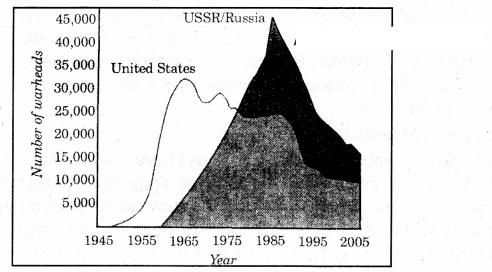
Graph: US and USSR nuclear stockpiles
Question (a) During 1955-2005, which country had the highest number of warheads?
Answer:
USSR / Russia
Question (b) What is the reason for decreasing In the nuclear stockpiles after 1985?
Answer:
- Tremendous public pressure
- Ban on nuclear tests
Question 6.
Observe the following map and answer the questions?
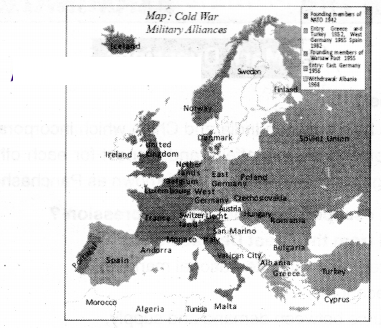
Question (a) What does the above map tell?
Answer:
The given map tells about cold war military alliances
Question (b) Why is united kingdom called as Island?
Answer:
United kingdom is called as an Island because it is covered by water on the sides
Question 7.
What are the basic principles of the UNO?
Answer:
The basic principles of the United Nations Organisation are preserving peace, upholding human rights, respecting international law and promoting social progress
Question 8.
What were the three of the most important processes?
Answer:
Even as the war-devastated countries rebuilt their economies, the world saw some new processes in place. Three of the most important processes were the establishment of the United Nations, Cold War and Decolonisation
Question 9.
Who drafted a charter for the formation of the UNO?
Answer:
The principal Allied countries like Britain, France, the USA, the USSR and China drafted a Charter for the formation of the UNO even as the war drew to an end.
Question 10.
Write the number of members of the UNO?
Answer:
At the time of its establishment UN had membership of 54 countries and today (2014) there are 193 countries
Question 11.
Which is the main body In the UNO?
Answer:
The General Assembly.
Question 12.
Who are the permanent members of the Security Council?
Answer:
China, France, United Kingdom; USSR (now Russia) and USA
Question 13.
Explain the Veto Power?
Answer:
Any decision taken by Council can be vetoed (made invalid or rejected) by the Intervention of even any one of these countries
Question 14.
Name some third-world countries?
Answer:
Countries emerging from colonial domination like Vietnam, Korea, Angola, and Afghanistan
Question 15.
Who got independence In 1960 and what happened then?
Answer:
The Belgian colony In Africa. Congo. got independence in 1960. But its radical communist leader, Patrice Lumumba, was killed in 1961, allegedly at the behest of US spy agency called CIA
Question 16.
When did Angola become Independent?
Answer:
Angola became independent from Portugual in November 1975
Question 17.
Expand NATO?
Answer:
North Atlantic Treaty Organisation
Question 18.
Expand SEATO?
Answer:
South East Asian Treaty Organisation
Question 19.
Expand CENTO?
Answer:
Central Treaty Organisation
Question 20.
What was the place of the USSR In space race?
Answer:
The USSR put the first satellite Sputnik and the first hurnanYun Gagarin in space
Question 21.
Whom did the US send to the moon?
Answer:
The US sent Neil Armstrong and others to the Moon n 1969
Question 22.
Expand NAM?
Answer:
Non-Alignment Movement
Question 23.
What were the cors concerns of th, people of recently de-colourised?
Answer:
The core concerns of people, especially those who were recently de-colonised like poverty, disease, inequality and colonialism were not addressed by any of these issues of contention
Question 24.
What does the West Asia refer to?
Answer:
West Asia refers to the region between Europe and Asia. The term middle East is also used to describe this area
Question 25.
What was called the Zionist Movement?
Answer:
A movement had developed among the Jews called the Zionist Movement Which called for uniting Jews spread across the world and to reclaim Palestine as their homeland and build a separate state of Jews
Question 26.
Who are Palestinians?
Answer:
Palestinians were mostly Arab Muslims
Question 27.
Expand PLO?
Answer:
Palestinian Liberation Organization
Question 28.
When and where was the PLO established?
Answer:
The PLO was established in 1964 in Jordon and added a new dimension by bringing together all different Arab factions. Its aim was to regain the land ¡t lost, without violence
Question 29.
Why did the US become unpopular?
Answer:
The US became unpopular because it supported undemocratic regimes In the Middle East so that the oil resources were available to the US and Its allies
Question 30.
What was the borderline between China and India?
Answer:
Mc Mahon Line
Question 31.
What is the main bone of contention between India and Pakistan?
Answer:
The main bone of contention between the two countries is Kashmir
Question 32.
Expand P0K?
Answer:
Pakistan Occupied Kashmir
Question 33.
Who was U Thanr?
Answer:
U Thant was the then Secretary General of UNO
Question 34.
What was Mukh Bahini?
Answer:
Suppoders of Mujibur Rahman organised a liberation struggle in the form of Mukti Bahini
Question 35.
Who signed Shimia Agreement?
Answer:
Zulfikar Alt Bhutto and Prime Minister Indira Gandhi
Question 36.
Who fought the Kargil War?
Answer:
India and Pakistan fought the Kargil war
Question 37.
When was Bangladesh liberated?
Answer:Bangladesh was liberated from Pakistan with hie help of Indian troops in 1972
Question 38.
What is IPKF?
Answer:
It is Indian peacekeeping force in Sri Lanka
Question 39.
What is a proxy war?
Answer:
A war Instigated by a major power that does not it self participate
Question 40.
Why do you think the cooperation between India and Bangladesh is vital for both countries?
Answer:
- Both the countries have cooperated on the economic front and river water
- Bangladesh is an integral part of the Indian Look East Policy to link up South Asia via Myanmar and both have cooperation on disaster management
Question 41.
Expand UNICEF?
Answer:
United Nations International Childrens Emergency Fund
Question 42.
Who formulated the NATO, the military alliance?
Answer:
United States of America / America
Question 43.
What is the boundary line between China and india?
Answer:
Mc Mahon Line is the boundary line between China and India
Question 44.
Explain the terms bipolarity and unipolarity?
Answer:
- Under the leadership of USA and USSR the world divided into two power blocks after World War II with different ideologies. This situation is called as bipolarity
- After the collapse of USSR, only USA remained as superpower in the world. This situation is called as unipolarity
Question 45.
What is Cold War?
Answer:
The absence of a real fighting as In traditional wars is called cold war. The cold war characterized by the intense tension between the USA and the USSR during 1945 to 1991
Question 46.
What is non-alignment movement?
Answer:
The policy followed by newly independent countries after Second World War, without involving in any of the military blocks, following neutrality in international politics
2 Marks Questions
Question 1.
What do you understand by Cold War?
Answer:
Cold War: Ideological differences between America and Russia is called Cold War
- It Is an indirect war. There as no real war
- It created mutual hatred, misbelief and enmity between Communist Russia and capitalist USA
- Both the USA and the USSR were n the possession of nuclear weapons
- They maintained secret alliances and treaties. Ex NATO, WARSAW
- Always they created a tension of war
- As the rival powers accumulated destructive weapons the world was constantly threatened by a nuclear holocaust
- People of all countries lived in constant fear of war
Question 2.
What suggestions do you give to maintain friendly relations with neighbouring countries?
Answer:
- No country at the present time can afford to exist m isolation
- From its very inception they have to maintain friendly relation with their neighbouring countries
- Maintain mutual confidence and trust based on heart-to-heart
- Rejects the role of a military power and committed to peace
- Should have greater understanding and cooperation among the people of neighbouring nations
- Should maintain friendly relations with neighbouring countries and blossom secularism, democracy and freedom here
- We should share peace and prosperity with the neighbouring countries
Question 3.
Write briefly about the present relations between India and Pakistan?
Answer:
Pakistan was separated from India and formed in 1947 as an Independent country. It as still supporting separation movements in Jammu and Kashmir in India. Pakistan is sending extremists to India to create some instability
India accuses that Pakistan is encouraging to send fake notes to India. It is violating the cease-fire conditions and causing for civilians and soldiers deaths. Modi visited Pakistan and discussed with the Prime Minister but the problem is not solved. India answered with surgical strikes. It was a great loss for Pakistan. I think the both countries should sit together and solve the problems to concentrate on development
Question 4.
Suggest measures for better relations between China and India?
Answer:
- Since 1962 India. Chinas relations are not good and fair
- Each should respect other country
- Panchsheel principles should be followed
- Settle disputes mutually with bilateral discussions
- Both countries should understand that they lose much more if there would be a war
Question 5.
Which were the worst affected countries In World War - II?
Answer:
The worst affected were the European countries, especially the USSR. Poland and Yugoslavia which lost about 20% of its population. In economic terms too the USSR and other European countries lost heavily with destruction of cities
Question 6.
Why had the World War- II been fought?
(OR)
What led to the formation of UNO?
Answer:
The Second World War had been fought on the principles of peace, democracy and freedom of nations in contrast to the Nazi ideas of dictatorship and Imperialism. Thus the first task was to establish a global organisation that would ensure peace and development in all nations. This led to the formation of the United Nations Organisation
Question 7.
Is the UNO successful In preventions wars?
Answer:
While the UN has been doing commendable work in the area of education, health, cultural exchange and protection of heritage, it has been less successful in preventing wars. It has often been held hostage to the ambitions of the superpowers that sought world control
Question 8.
Which is called a Cold war?
Answer:
For more than forty-five years after the Second World War, a rather strange war was fought between the two blocks. It was a war in which the principal contenders did not physically attack each other or fight each other directly and hence, there was no hot war. Instead, a War was fought behind closed doors through propaganda and words. It is called the Cold War
Question 9.
Why is It called the Cold war?
Answer:
It is called the Cold War simply because of the absence of a real fighting as in traditional wars. This Cold War characterised by intense tension between the United States and the USSR, influenced and shaped almost everything that happened in the world between 1945 and 1991
Question 10.
What was the result of Atghanlsthan Invasion by the USSR?
Answer:
In 1971 the USSR invaded Afghanistan to install a friendly government there. The US in turn provided armed support to Afghan rebels who were also religious extremists. A prolonged civil war ensued and as the USSR decided to withdraw from Afghanistan in 1985 that country fell to religious extremists led by the Taliban which now turned against the USA
Question 11.
How did the Alliances help the superpowers?
Answer:
The alliances heed super powers which wanted to expand their influence to gain access to the vital resources like oil and minerals markets for their products and places to safely invest their capital military bases to launch their troops and weapons spread their ideology and gain economic support, to pay huge military expenses
Question 14.
Explain the significance of the Bandung conference?
Answer:
in 1955 at Bandung Indonesia, a conference was held. it was the first Asio-African conference represented by 29 nations. The most important leaders of this conference were Pandit Jawaharlal Nehru the then Prime Minister of India, Gamal Abdul Nasser the leader of Egypt and Josip Broz Tito the leader of Yugoslavia. Pt. Nehru was acknowledged as the chief spokesperson. It paved the way for Non-Aligned Movement (NAM)
Question 15.
What have often described as the West Asian Crises? Write about them?
Answer:
The conflicts that developed between Arabs and Jews are often described as the West Asian Crises. it was mainly related to the occupation of Palestine. Palestine which was in habitad by Arabs was under the control of Britain before Second World War. in It Is situated Jerusalem which is a holy city for Jews. Christians and Muslims alike
Question 16.
Write about Taliban of Afghanistan?
Answer:
The Taliban which took over Afghanistan after the withdrawal of Soviet troops similarly established an extremist Islamic state. These states tried to force afl people to strictly follow the rules laid down in religious texts. in many cases, this meant the denial of basic freedom and equality of opportunity to women and to religious minorities
Question 17.
Which led to a war against Iraq?
Answer:
The beginning of the twenty-first century witnessed growing discontent among the Arabs which resulted in the growth of religious terrorism. Some Arab terrorists hijacked two aircrafts in the US and crashed into the World Trade Centre in New York killing thousands of people. This led to a war against Taliban and eventually to a war against Iraq
Question 18.
Write about Mikhali Gorbachev?
Answer:
Mikhail Gorbachev n the USSR tried to transform the politics of USSR by making it more open and bringing about radical changes. He was a liberal who introduced certain reforms for the revival of their economy and promoted healthy relations with the West. The reforms introduced by the open remain are often described as Glasnostand Perestroika
Question 19.
Why Is China considering India as an adversary?
Answer:
India gave asylum to Dalai Lama, this caused a conflict, and Chinese started considering India as an adversary. Prior to this, a border dispute had surfaced between India and China. China laid claim to Aksai-chin area In Ladakh region and much of Arunachal Pradesh
Question 20.
Write about the indo-China war 1962?
Answer:
China invaded India in October 1962 violating the peace treaties It signed with India. india was not prepared for this surprise attack and suffered much losses. Eventually, China declared unilateral ceasefire and withdrew its troops to its pro-war position. It took more than a decade to resume normal relations. Full diplomatic relations were restored only in 1976
Question 21.
How has Non-Alignment Movement emerged?
Answer:
- A large number of developing countries that had attained independence after the World War li, during cold war era, in order to maintain their hard-won freedom, decided to stay away from the arena of superpower rivalry
- The non-Alignment movement emerged under the leadership of india. Egypt and Yugoslavia came Into existence which added a new dimension lo world politics
Question 22.
Observe the following graph and answer the following questions.
Graph Indias and Pakistans Military Expenditures?
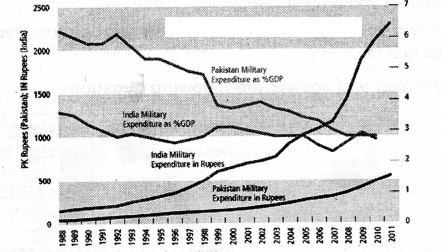
Question 1. Which country had spent more on Military Expenditure in its GDP?
Answer:
Pakistan had spent more on military expenditure as % GDP
Question 2. What does the graph show?
Answer:
The graph shows Indias and Pakistans Military Expenditures
Question 23.
To emphasise the determination for peace, Jawaharlal Nehru formulated his renowned Panchsheel principles?
- Respect for each others sovereignty and territorial integrity
- Non-Interference in the internal affairs of other countries
- Non-aggression and settlement of disputes with mutual understanding
- Endeavour to achieve cooperation and mutual respect in international relationships
- Promoting peaceful co-existence
Question i. In between which countries, the Panchsheel was formulated?
Answer:
India and China
Question ii. Mention any two principles of Panchsheel?
Answer:
- Respect for each others sovereignty and territorial integrity
- Non-interference in the internal affairs of other countries
- Non-aggression and settlement of disputes with mutual understanding
- Endeavour to achieve cooperation and mutual respect in international relationships
- Promoting peaceful co-existence
Question 24.
Observe the following Map and answer the questions given below?
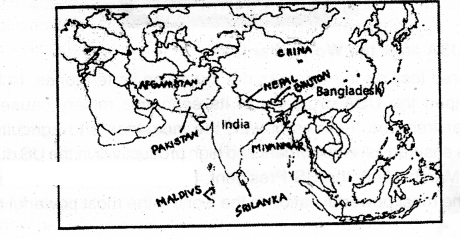
Question (A) Write any two countries which are sharing boundary with India on Northeastern side?
Answer:
Nepal, Bhutan and Bangladesh
Question (B) Mention two countries which are sharing sea-boundary with India?
Answer:
Sri Lanka and Maldives
Question 25.
Observe the map and answer the following questions?
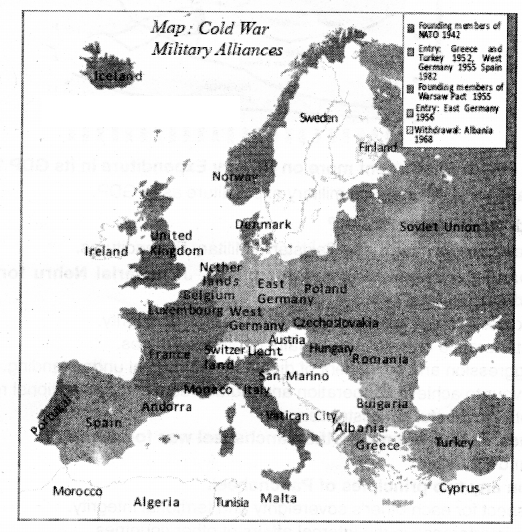
Question (a) Name any two countries of NATO at the founding (.stablishment) time?
Answer:
France and Iceland
Question (b) Name any two Countries which were under the WARSAW?
Answer:
Poland and Czekoslovakia
4 Marks Questions
Question 1.
What is the NAM? What are Its main objectives?
Answer:
NAM:
- Not joining In any powerful block either the USA block or the USSR block
- Maintaining equal chance and behaving independently
Objectives:
- Maintain the world peace
- MaintaIn the cooperation among the member nations
- To prevent any of the newly decolonised independent countries from joining any of the military blocks
- Estimate the growing cold war tensions and its impact on the world at large
.
Question 2.
What is the role of the UNO in maintaining world peace?
Answer:
In order to build peace in the world the U.N.O. plays its prominent role as below.
The U.N.O. was established on 24th October. 1945
- It prevented the Cold War
- It succeeded in getting independence to Indonesia from the Dutch
- It solved the dispute in Palestina between Arabs and Jews by creating a separate state of Israel for Jews
- It succeeded in averting a war between England and Egypt over Suez Canal issue
- It created Pressure on Russia and the U.S.A. to the receiving of nuclear weapons
- it helped Congo to get freedom
- U.N. helped to defuse Cuban missile crisis, middle east crisis
- UN-sponsored peace settlement ended Iran Iraq war
- UN-sponsored negotiations led to withdrawal of Soviet troops from Afghanistan
- It helped Cyprus to avert conflict between Greeks and Turks
- When Pakistan resorted to aggression over Kashmir It intervened and tned to avert the war between lndia and Pakistan
- It helped to Angola to get Independence from Portugal
- So far it has been able to prevent a Third World War
Question 3.
Why Is peace between India and Pakistan necessary for the development of both the countries?
Answer:
- Both India and Pakistan have nuclear status and in this scenario the need of peace process between them is much more important than ever before
- Any kind of conventional armed conflict can change into a nuclear war
- So the peace process should be based on development of the both the countries
- For social, political and economical development of the both the countries, peace should be established between them
Question 4.
Is Veto power to a few countries In the UNO, helping or barrier for World Peace? Discuss?
Answer:
Sometimes Veto power is working as a barrier and also helpful to world peace.
How it is barrier:
- Often the great powers themselves involved In many of the conflicts used their Veto power to block any action by the U.N.O
- Sometimes they have also used their power to force the UN to bend to their dictates
How It is helping:
The special powers so have given the great powers a special role and responsibility In preserving world peace.
U.N.O created pressure on Russia and the USA to the reducing of nuclear weapons.
U.N.O helped to defuse Cuban missile crisis.
However, the very existence of a forum like UN, has forced great powers to exercise moderation and self-control
Question 5.
Observe the given graph and analyse It.
Indias end Pakistans Military Expenditures?
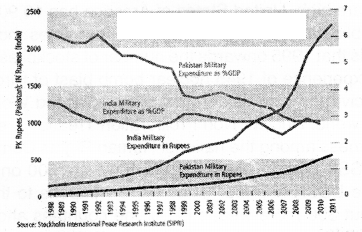
Answer:
- The graph explains about india arid Pakistan military expenditures
- Pakistan spent more on military expenditure as % GDP
- The military expenditure of India was also high
- India spent less on military expenditure as % GDP. Both countries gave importance to gather more and more weapons because always Pakistan is provoking India on the issue of Jammu & Kashmir. In 2016 Ud incident also happened. India
- faces problem with China also
(or)
Since 1988 Pakistans military expenditure has not been high. Since 2000 onwards It has been increasing. Though the amount is increased its expenditure in GDP percentage is decreasing. It seems to be less but in total it is more and dangerous to its neighbouring countries like India. At the same time, India is also increasing its expenditure on rrslitary to protect its people from neighbouring countries
Question 6.
Write a detailed note on West Asian conflicts?
Answer:
Jerusalem is a holy city for Jews, Christians, Muslims alike. The Jews consider Palestine as their Promised Land. The conflict came to a head in Germany under the Nazis when millions of Jews of Europe were jailed and killed. Zionist movement spread across the world and tried to reclaim Palestine as their homeland. This demand was supported by the Western powers
Both the USA and the USSR wanted to bring this region of massive oil reserves under their control. UN divided into two parts Arab and the Jew" states. The Arabs refused to recognize Israel as a legitimate state. Egypt came in support of Palestine but in 1956 Israel attacked Egypt with the support of Western Powers. Israel withdrew the army. The Palestine Uberabon Organization encouraged the Arabs to attack Israel
Yasser Arafat carried out terrorist attacks. Later he gave up terrorist attacks and agreed to find a peaceful solution. He died in 2004 and the Palestinians are still fighting for their homeland
Question 7.
Observe the following table and analyze it with regard to the trend of nuclear weapons stockpiles.
Nuclear Weapons Stockpiles (1990 - 2014)?
| Country |
1990 |
1995 |
2000 |
2005 |
2014 |
| USA |
10,904 |
10,577 |
8,360 |
7,700 |
7,260 |
| Russia/USSR |
37,000 |
27,000 |
21,500 |
17,000 |
7,500 |
Answer:
The given table is about nuclear weapons stockpiles during the period 1990-2014. In this table the super powers United States of America and Union of Soviet Socialist Republic are conared. In the beginning, the frequency of period is five years but in the ending 2014 is given immediately after 2005
During 1990 the nuclear weapons stockpiles with both the countries are high. United States of Armenia has 10 904 whereas Union of Soviet Socialist Republic has 37,000, This is about four times more than the weapons of USA. The wonders that 1995 onwards the number of stockpiles is reducing
It has many reasons. It is the experience of 1945 nuclear bomb blast of Hiroshima and Nagasaki of Japan. Millions of civilians also died in that blast. Second World War brought various experiences to the world. Nuclear Non Proliferation Treaties are also the reasons
UNO also brought awareness among the nations. Human Rights Commissions also tried well. During 2014 the USSR brought the weapons down to 7500 only. This is realty drastic reduce. In 1990 the USSR has four times more weapons to the USA whereas during 2014 ii is only about 300 more weapons
All the countries should think that if nuclear weapons are used in the wars, there will be much destruction to the mankind, Superpowers and developing countries also concentrate on reducing the nuclear weapons. Recently North Korea tested these weapons and created much tension among the countries. So everyone should respect the peace
Question 8.
Under the present circumstances, give suggestions to build cordial relations between India and Its neighbouring countries?
(OR)
Why should India have cordial relations with neighbouring countries?
Answer:
- India was founder of the NAM which sought to keep an independent position between the two superpowers
- India tried to base its foreign policy on the Gandhian principles of peace and non-violence
- India Is emerging as a major world economic and political power. So, it should get support from the neighbours and in turn help them
- It should take measures to maintain peace and tranquillity at the borders, which is possible only with cordial relations with neighbours
- It has shared culture and civilisation with neighbouring countries, thus built bridges of friendship through trade, sports, films, tourism and cultural exchanges
- It shall have greater understanding and cooperation among the people of neighbouring nations
- It shall have friendly relations with neighbouring countries and blossom secularism. democracy and freedom here
- It shall have cooperation with neighbours on disaster management
Question 9.
Describe the present circumstances that are threatening world peace?
Answer:
Present circumstances that are threatening world peace
- Terrorism
- Wars
- Armament race
- Invasions
- Communalism
- Exploitation of resources
- Interference of developed countries in the affairs of developing countries
- Aggressive nationalism
Question 10.
Observe the following table and analyse It.
US and USSR Nuclear Stockpiles (Number of warheads)?
| Year |
US |
USSR |
| 1965 |
33,000 |
10,000 |
| 1975 |
25,000 |
32,000 |
| 1985 |
24,000 |
45,000 |
| 1995 |
12,000 |
25,000 |
| 2005 |
11,000 |
16,000 |
Answer:
Table Analysis:
From the given table we understand that from the year 1965 to 2005 the U.S stock piles gradually decreased. 21 In the U.S.S.R the stockpiles Increased from 1965 to 1985. and then decreased till 2005.
Reason for increasing the stockpiles: At the bening the stockpiles nurturer is increased due to military supremacy and to gain economic supremacy that lead the countries to emerge camps after Second World War
Reasons for decreasing their stockpiles:
- Both the countries realised that warmongering and the consequent arms race only made the world more unsafe and increased the possibility of a disastrous war for all countries
- As a result of the pressures the USA and the USSR, the main competitors in the arms race signed on cut down their nuclear orsenal
- Cold war came to an end with the collapse of the USSR In 1991; Is also another reason for this
Question 11.
Give suggestions to solve the differences among the countries of Non-Aligned Movement?
Answer:
Suggestions to solve the differences among the countries of Non-Aligned Movement
- Respect for each others sovereignty and territorial integrity
- Non-interference in the internal affairs of other countries
- Non-aggression and settlement of disputes with mutual understanding
- Endeavour to achieve mutual respect and cooperation in international relationships
- Promoting peaceful co-existence
Question 12.
Read the given paragraph and write your opinion.
Dunng the last few decades. Tribal and Marginal farmers have also been threatened by CorrerciaI farmers, mining corporations, dam projects, etc. As the large currencies find rare resources in remote rural areas, like minerals, rare plants or annals and water, there has been a rapid increase in the ousting of the farming and tribal population from traditional areas?
Answer:
According to the given paragraph, the marginalised communities are being neglected and mostly they are exploited. Big companies Invest money for their benefits and so the tribal people are far away from agriculture forcefully
Mining corporations take permission from the mineral development Department or the government and they start mining. Sometimes government plan to construct dams so as to get the water irrigated to feed lakhs of hectares of cultivable Land and in some cases uncultivable land also will be converted to cultivable. The people in foothills of the hills mountains or forests will be asked to migrate to other places
Sometimes It is a must. Then they oppose the construction of dams and other developmental activities. Government has to give sufficient correlation,, to the land losers. Moreover, it is better to provide land in place of land, but it should be of same quality cultivable When farmers, and tribals are asked to vacate where do they go
Without proper planning it impossible to move. In some localities like Yeliampally and Mid Manair areas the land losers got sufficient compensation and so they settled in new colonies. In Kudamkulam in Tamilnadu, Narmada dam construction the land losers are not satisfied
Question 13.
How was the USA after the World War II?
Answer:
The USA suffered less as the war was not fought on its territories. In fact the Second World War helped the USA grow out of its economic misery caused by the Great Depression. Far from the theatres of war, the industries and agriculture of the USA prospered
This ensured full employment and high productivity in the US during the Second World War. In March 1945, the US President, Harry Truman, said, We have emerged from this War the most powerful nation ¡n the world - the most powerful nation, perhaps, in all history
Question 14.
Explain the organs of the UNO?
Answer:
The UN works through six different organs. Each of these organs has specific functions like maintaining peace and security, improving education and health facilities. alleviating poverty, providing justice in the context of international crimes and so on
Some bodies responsible for these functions Include International Court of Justice located in Hague; the World Health Organisation located at Geneva. the United Nations Educational. Scientific and Cultural Organisation functioning from Paris, and United Nations ChildrecYs Emergency Fund functioning from New York
Question 15.
Explain the blocks In the world (1945 - 1991)?
Answer:
Two major ideological and political camps emerged in the post-war period - the Communist block led by the USSR and the Democratic Capitalist Block led by the USA. On the one hand, the USSR promoted the ideas of equality and state controlled development and suppression of opposition to these principles. On the other hand USA promoted the ideas of multi-party democracy and private capitalist controlled process of development. The USSR had the entire Eastern Europe (Poland. Hungary, and East Germany) under its
influence and many colonies which were gaining freedom like China and Vietnam were closely aligned to it
The countries of Western Europe like Britain, France, Spain were closely allied with the USA. The two blocks competed with each other for bringing all the intermediate countries in their blocks
Question 16.
Write about the military alliances?
Answer:
Both the USA and the USSR were in the possession of nuclear weapons but knew very well neither would be the winner in a nuclear war. Yet, they formed military and strategic alliances- the west formalised its allïances in an organisation known as North Atlantic Treaty Organisation (NATO) in 1949
To counter this. Communist nations made similar alliances and signed the Warsaw Pact. In addition to this, the US established regional military and strategic alliances like South East AsianTrealy Organisation (SEATO) and Central Treaty Organisation (CENTO)
Question 17.
Write about the NAPA?
Answer:
Non-alignment was established as an international organisation with an aim to promote cultural and economic cooperation among the newly independent countries of Asia, Africa and later Latin America
The first Summit was held at Belgrade in Yugoslavia in September 1961. It was attended by 25 member countries. By 2012, the membership has grown to 120 Countries with 17 Observers.
The first Summit was the culmination of three major concerns:
Cooperation among the member nations of NAM most of them who had newly emerged as free countries.
Growing Cold War tensions and its impact on the world at large. Lastly, to prevent any of the newly decolonised Independent countries from joining any of the military blocks
Question 18.
Who made an effort to unite the Arabs? Explain it?
Answer:
The President of Egypt Gamal Abdel Nasser (1918-1970) made an effort to unite the Arabs. He formed fidayeens (suicide squads) for causing explosions in public places in Israel. He adopted aggressive policies against Britain and France and demanded that Britain should withdraw its troops from the Suez Canal. The United States withdrew aid to Egypt for the construction of Aswan Dacn. Nasser nationalised Suez Canal with the support of USSR who supplied arms and ammunition for Egypts struggle against the West
Question 19.
Who formulated Panchasheel principles and write about them?
Answer:
India tends to base its foreign policy on the Qandhian principles of peace and non-violence. To emphasise its determination for peace Jawaharlal Nehru formulated his renowned
Panchsheel principles:
- Respect for each others sovereignty and ten-Itonal integrity
- Non-interference in the internal affairs of other countries
- Non-aggressIon and settlement of disputes with mutual understanding
- Endeavour to achieve cooperation and mutual respect in International relationships
- Promoting peaceful coexistence
These were to determine Indias relations with other countries, especially its neighbours China. Pakistan, Sri Lanka and subsequently Bangladesh
Question 20.
What were the effects of cold war and military alliances?
Answer:
- The rivalry between superpowers has produced endless friction
- The dream of creating one world with all the people living in peace, was shattered
- The cold war resulted in a race of armaments
- The military alliances like NATO, Warsaw pact, SEATO and CENTO resulted In competition for armaments - conventional and nuclear
- The effect of cold war was detrimental to the progress of humanity
- The diversion of worlds economic resources for armament production had adversely affected economic development of the world
- The intensificatIon of cold war has enhanced the difficulty of all the countries irrespective of their involvement In the cold war
- If civilization is to survive, nations should give up armaments competition and accept peaceful coexistence as the only alternative to total annihilation
Question 21.
Two world wars were proved to be the cause for death and destruction. What would happen If Third World War were to happen?
Answer:
- The death and destruction caused by world wars was unprecedented
- World War I had claimed 10 million men In battle
- About 22-25 million military casualitles and deaths of 40-52 million civilians In the World War II
- After effects of the atom bombs dropped, diseases like leukaemia and cancer lingered for decades
- If the Third World War were to happen, it may have for reaching effects
- The world may be smashed within no time as the countries of the world are now equipped with such technology and ammunition and weapons
- Now many countries rise to the status of nuclear countries, the technology which can be the most destructive
- But, United Nations Organization and all the countries on their own are avoiding it to happen
Question 22.
Observe the following graph?
Graph: US and USSR nuclear stockpiles
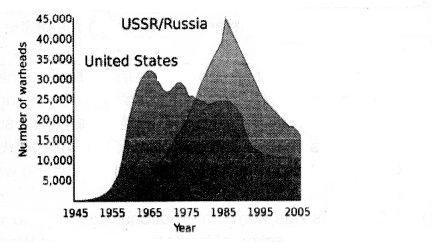
Question 1. What does the graph show?
Answer:
The graph shows the US and USSR nuclear stockpiles
Question 2. Which country had highest number of warheads In 1985?
Answer:
In 1985, Russia had the highest number ol warheads
Question 3. Why did the warheads competition take place In between the US and the USSR after 1945?
Answer:
There were Ideological differences between the USA and the USSR. leading to Cold War, resulted in warheads competition
Question 4. Which country had less arms In 2005?
Answer:
The USA had loss amis In 2005
Question 23.
On the outline map of world Identify the following locations?
- Egypt
- Indonesia
- Israel
- Palestino
- China
- Spain
- Belgium
- Congo
- Chile
- Jordan
- Afghanistan
- Bangladesh
Answer:
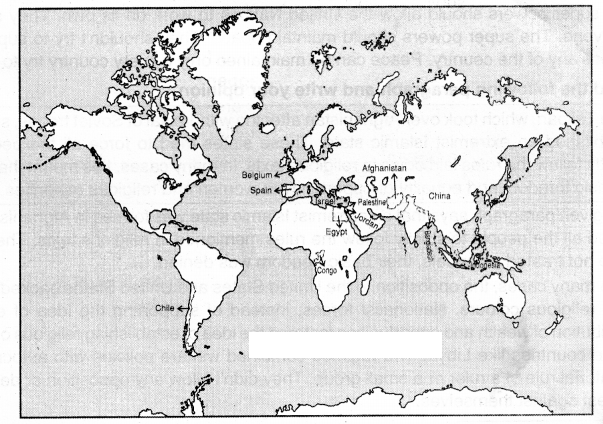
Question 24.
Read the following paragraph and interpret Ii.
"While the UN has been doing commendable work in the area of education, health, cultural exchange and protection of heritage, it has been less successful in preventing wars, It has often been held hostage to the ambitions of the super-powers who seek Control over the world?
Answer:
The summary of the given paragraph is that United Natìons he been doing better service in socio-cultural areas but it is not so successful in preventing wars. The supers control the UN and they lead to wars, Hence UN is not doing anything successfully to prevent wars. United Nations Organisation was established on 24th October 1945. Its headquarter Is at New York. It was formed with the intention of preventing wars and maintaining peace everywhere
The United Nations has some international agencies to work for the betterment of education, health and protection of heritage UNDP and World Health Organisation are working in this regard. Many countries in the world are not providing sufficient medical care So UN contributes a lot. At the time of natural calamities, UN agencies come forward and give a helping hand to the victims. They send food and commodities. The agencies are concentrating on vaccinations to prevent various types of diseases. They provide medicines also. Literacy improvement programmes are also taken up
The real aim of United Nations is to prevent wars and maintain peace all over the world. To discharge this duty, United Nations needs its own army but its has multinational force. This force is provided by many of the nations which follow imperialistic way of living. The superpowers like America and Russia develop enmity among nations and try to improve their polarization. After the Second World War, the world was divided into two poles. The countries which came forward to form the United Nations are not fully cooperating in bringing peace
In conclusion, I say that the United Nations is not doing its dirty well. I agree with the content of the paragraph given. As a social organization, the United Nations is working well. Social, economical, cultural development will be collapsed if wars are not prevented.
The superpowers should allow the United Nations to work on its own. They shouldnt intervene. The superpowers should maintain peace. They shouldnt try to suppress or oppress any of the country. Peace can be maintained only if every country try to follow it
Question 25.
Read the following paragraph and write your opinion.
The Taliban, which took over Afghanistan after the withdrawal of Soviet troops, similarly established an extremist Islamic state. These states tried to force all the people to strictly follow the rules laid down in religious texts. In many cases, this meant the denial of basic freedom and equality of opportunity to women arid religious minorities The given paragraph says that an extremist Islamic state was formed in Afghanistan?
Answer:This forced all the people to strictly follow the rules mentioned in religious texts. The women were not treated as equals. their basic freedom was denied. In many cases, the opposition to the United States and United States-backed regimes took religious colours. Nationalist forces, instead of supporting the idea of equitable distribution of wealth arid opportunities fostered the idea of establishing religious orthodoxy in the countries like Libya. The remes combined welfare policies with autocratic and dictatorial rule of a ruler or a small group. They didnt allow any opposition or democratic protest against themselves
A revolution took place in Iran in 1979 in which the old king of Iran, who was supported by United States was removed and a new government jointly controlled by Shia Islamic cienos and democratically elected leaders was established.
The Taliban are extremists in Afghanistan. Once they fired a girl named Malala for voice for education. She was identified easily as she didnt wear the burkha in a bus, So she was short. She was rescued and later on given Nobel Prize. The Talibans insisted everyone to follow the rules laid down in religious texts
My opinion is that one should follow the religious rules with understanding them and they should be followed heartfully. Religion ris personal - No one can torce anyone to follow some rules or flow the same.
The Talibans do not allow women to have basic freedom. The women have no equal rights. In modem society all the men and women are equal in getting opportunities. Many Kuman Rights Comrrwssiocis and Non-Governmental Organisations are working for the women, children and for the sake of the downtrodden groups
be women were given right to vote after many agitations and movements. In 21st century. we can expect discrimination. Religious texts, rules can be explained for understanding and following of them should be left to the individuals. Fundamentalism leads to dissatisfaction to some of the citizens
By concluding I say, giving respect and following ones religion is completely personal and individual. There should be no denial of basic freedom and equality of opportunity to women and religious minorities. In Indian Minorities are given special protection. Provision is there in the Constitution with 29. 30 Articles
Question 26.
Read the following paragraph and comment on it.
"Over the years, the NAM helped countries like India to take an independent position when the two superpowers tell apart and pulled countries to their side. It also helped the newly emerging countries to bargain for space and assistance from the superpowers by playing one against the other. To some extent, it also helped to ease tensions amongst the NAM countries?
Answer:
According to the paragraph the Non-Aligned Movement helped many countries like India to get Independent position. NAM encouraged countries not to join any of the superpower blocks. The tension was eased among the NAM countries
When the Second World War was ended, the world was divided into two blocks. One block was headed by United States of America and the other, by Union of Soviet Socialist Republic. US was a Capitalist block and USSR was a Socialist block. They attracted many of the countries to join their groups. In 1947 India got independence and these two blocks expected that India would join in these groups. India decided not to join any of these groups.
A conference was held in Bandung in Indonesia, and it was decided to form Non-Alignment Movement. Its first summit was held in Yugoslavia with 25 member countries. Gradually the number increased to more than 120 countries
The two power blocks pulled countries to their side by implementing different doctrines like Marshall plan. Maithove plan and so on. They came forward to help by giving loans for reconstructing the economies.
The whole world was under tension, that what will happen if these two superpowers continue their enmity and conspiracies. The whole world was afraid of its future. When NAM came into existence, the tension was reduced. There is a hope of ray in the world. Many of the countries are small In size and resources. They are afraid of these superpowers
These superpowers want to dominate the world. Some satire is there, that one of these two powers want to play the tote of sarpancti feeling the entire world as a gram panchayat. This type of psychology destructs the worlds stability, In conclusion, the present age is democratic age. Every country wants to develop its own keeping the aspirations and needs to its people.
All the countries, though they are small, want to work for the welfare of the people. This age is welfare age. US and USSR should concentrate on their countries only. They shouldnt intervene wi the fields of others
The freedom of every country should be given respect In the gameplay of these superpowers small and newly independent countries shouldnt become the victims. NAM is neither closer to US nor USSR. They are kept at equal distances. We are not against to any of these groups. Democracy and independence with sovereignty are to be given importance
Question 26.
Read the following paragraph and interpret It.
"Pakistan has, over the years. encouraged separatist movements in the border states of India like Punjab, Jammu and Kashmir. India has often accused Pakistan of not only supporting such movements but actively training and sending religious extremists to foment trouble in India. Pakistan, In turn, has been accusing India of hying to destabilise it and constantly threatening it with military action and stockpiling of nuclear arms and
missile?
Answer:
According to the given paragraph Pakistan is separate and armed sri independent country but it is still supporting separation movements in Jammu and Kashmir. Pakistan is now sending extremists to India lo create unstable situation. Pakistan is accusing India of trying to destabilize. India is increasing its stockpiles of nuclear weapons and missiles. Hence Pakistan is being in a threat
When India was under the British rule. Pakistan was not formed. It was a part of India. Since 1930s. there was demand from Muslims to separate their country. It was on the basis of religion. In 1947, India got independence and it was divided. East and West Pakistan came to a struggle in 1970$. East Bengal, that was the East Pakistan turned against the West Pakistan and so there was a war. India gave support to East Pakistan
and won the war. After the war East Pakistan became Bangladesh.
Pakistan was supporting the terrorists and trying to create troubles. In 1948 and 1965 Pakistan attacked India. In Karg.l, Pakistan also started a war. In all the wars, Pakistan was defeated by Indian army. Recently Pakistans conspiracy of fake notes In India came into light. Crores of rupees were sent to India to destabilise the Indian economy but the police traced it. Many of the Illegal persons are coming by crossing the border. Terrorist
activities are strengthening in India with their support
On International daises. Pakistan is raising the issue of Kashrrnr, with regard to Kashmir bilateral discussions are in progress but tNt now it didnt come to an end. India and Pakistan, both the countries are increasing their stock piles of nuclear arms and missiles.
The world has already seen and experienced the effect of nuclear blast at Nagasaki and Hiroshima. If it is repeated now, no one will be rescued. Enormous human holocaust will be taken place
In conclusion, I would say that both India and Pakistan should spend their money on public facilities and try to develop their countries. Foc the sake of Kashmir, Pakistan should not try to destabilize Indian political-economic situation, One should understand the conditions of the poor In two countries and they should sit together and find a solution
Question 27.
Observe the Europe map and write any two countries from the WARSA p00l and any two countries from the NATO pool?
Answer:
NATO Pool
- USA
- Canada
- Belgium
- Denmark
- France
- Portugal
- Britain, etc
WARSA Pool
- Poland
- Albania
- Rumania
- Bulgaria
- Hungary, etc
Question 28.
Observe the graph given below and answer the following questions?
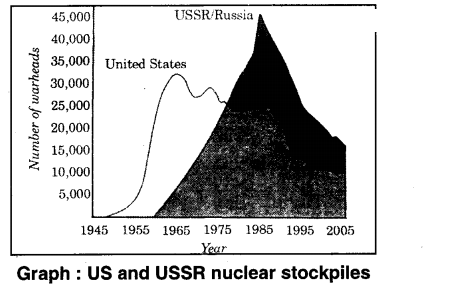
Question 1. Which country has more nuclear stockpiles during 1955-1975?
Answer:
United States of America
Question 2. What Is the number of warheads that United States had In 1965?
Answer:
Nearly 30,000
Question 3. What led the countries to emerg camps after Second World War?
Answer:
- Ideological conflicts between US and USSR
- For military supremacy and to gain economic supremacy lead the countries to emerge camps after Second World War
Question 4. Why did the countries decrease their nuclear stockpiles after 1990?
Answer:
- Realised that warmongering and the consequent arms race only macle the world more unsafe and increased the possibility of a disastrous war for all countries
- As e result of the pressures the USA and USSR, the main competitors in the arms race, signed on cut down their nuclear arsenal (SALT, START)
- Cold war came to an end with the collapses of USSR in 1991; is also another reason for this
Question 29.
Locate the following in the given map of World?
- Congo
- Germany
- FascIsm belongs to this country
- Headquarters of League of Nations
Answer:
Geneva
- Czecoslavakie
- Rumania
- Mediterranean sea
- Burma / Myanmar
- Australia
- Bulgaria
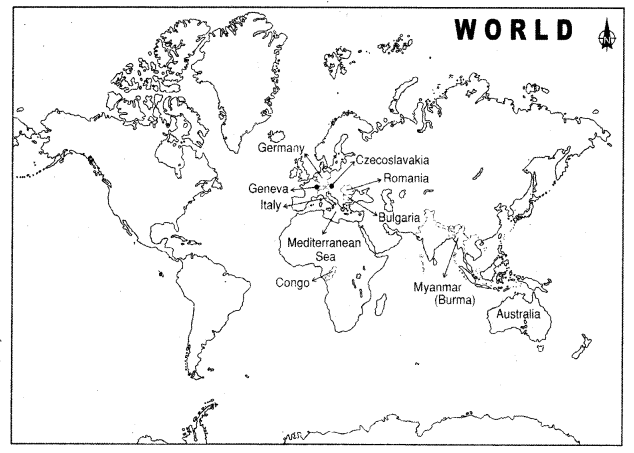
Question Papers / Notes Download